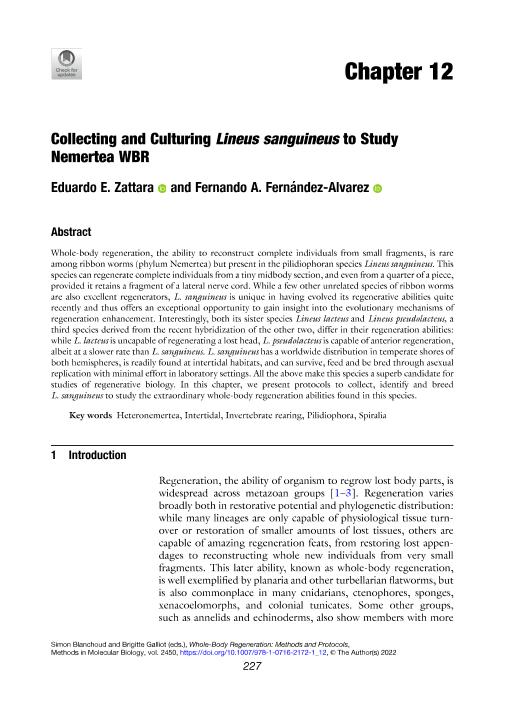Capítulo de Libro
Collecting and Culturing Lineus sanguineus to Study Nemertea WBR
Título del libro: Whole-Body Regeneration: Methods and Protocols
Fecha de publicación:
2022
Editorial:
Humana Press
ISSN:
1064-3745
e-ISSN:
1940-6029
ISBN:
978-1-0716-2171-4
Idioma:
Inglés
Clasificación temática:
Resumen
Whole-body regeneration, the ability to reconstruct complete individuals from small fragments, is rare among ribbon worms (phylum Nemertea) but present in the pilidiophoran species Lineus sanguineus. This species can regenerate complete individuals from a tiny midbody section, and even from a quarter of a piece, provided it retains a fragment of a lateral nerve cord. While a few other unrelated species of ribbon worms are also excellent regenerators, L. sanguineus is unique in having evolved its regenerative abilities quite recently and thus offers an exceptional opportunity to gain insight into the evolutionary mechanisms of regeneration enhancement. Interestingly, both its sister species Lineus lacteus and Lineus pseudolacteus, a third species derived from the recent hybridization of the other two, differ in their regeneration abilities: while L. lacteus is uncapable of regenerating a lost head, L. pseudolacteus is capable of anterior regeneration, albeit at a slower rate than L. sanguineus. L. sanguineus has a worldwide distribution in temperate shores of both hemispheres, is readily found at intertidal habitats, and can survive, feed and be bred through asexual replication with minimal effort in laboratory settings. All the above make this species a superb candidate for studies of regenerative biology. In this chapter, we present protocols to collect, identify and breed L. sanguineus to study the extraordinary whole-body regeneration abilities found in this species.
Palabras clave:
Heteronemertea
,
Intertidal
,
Invertebrate rearing
,
Pilidiophora
,
Spiralia
Archivos asociados
Licencia
Identificadores
Colecciones
Capítulos de libros(INIBIOMA)
Capítulos de libros de INST. DE INVEST.EN BIODIVERSIDAD Y MEDIOAMBIENTE
Capítulos de libros de INST. DE INVEST.EN BIODIVERSIDAD Y MEDIOAMBIENTE
Citación
Zattara, Eduardo Enrique; Fernández Álvarez, Fernando Ángel; Collecting and Culturing Lineus sanguineus to Study Nemertea WBR; Humana Press; 2022; 227-243
Compartir
Altmétricas




